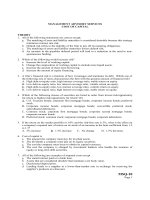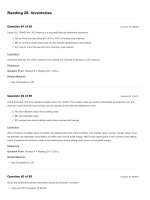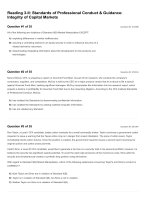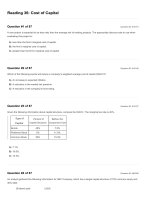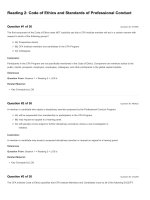Reading 28 uses of capital answers
Bạn đang xem bản rút gọn của tài liệu. Xem và tải ngay bản đầy đủ của tài liệu tại đây (287.11 KB, 17 trang )
Question #1 of 28
Question ID: 1378647
Johnson's Jar Lids is deciding whether to begin producing jars. Johnson's pays a consultant
$50,000 for market research that concludes Johnson's sales of jar lids will increase by 5% if it
also produces jars. In choosing the cash flows to include when evaluating a project to begin
producing jars, Johnson's should:
A)
B)
C)
include the cost of the market research and exclude the effect on the sales of
jar lids.
include both the cost of the market research and the effect on the sales of jar
lids.
exclude the cost of the market research and include the effect on the sales of jar
lids.
Explanation
Sunk costs should be excluded from cash flows, as they are costs that cannot be avoided
even if the project is not undertaken. Externalities, such as positive or negative effects of
accepting a project on sales of the company's existing products, should be included in the
cash flows.
For Further Reference:
(Study Session 9, Module 28.1, LOS 28.a)
CFA® Program Curriculum, Volume 3, page 645
Question #2 of 28
Question ID: 1378661
Jack Smith, CFA, is analyzing independent investment projects X and Y. Smith has calculated
the net present value (NPV) and internal rate of return (IRR) for each project:
Project X: NPV = $250; IRR = 15%
Project Y: NPV = $5,000; IRR = 8%
Smith should make which of the following recommendations concerning the two projects?
A) Accept Project Y only.
B) Accept both projects.
C) Accept Project X only.
Explanation
The projects are independent, meaning that either one or both projects may be chosen.
Both projects have positive NPVs, therefore both projects add to shareholder wealth and
both projects should be accepted.
(Study Session 9, Module 28.2, LOS 28.b)
Question #3 of 28
Question ID: 1383114
One of the basic principles of capital budgeting is that:
A) decisions are based on cash flows.
B) projects should be analyzed on a pre-tax basis.
C) opportunity costs should be excluded from the analysis of a project.
Explanation
The five key principles of the capital budgeting process are:
1.
2.
3.
4.
5.
Decisions are based on cash flows, not accounting income.
Cash flows are based on opportunity costs.
The timing of cash flows is important.
Cash flows are analyzed on an after-tax basis.
Financing costs are reflected in the project's required rate of return.
(Study Session 9, Module 28.1, LOS 28.a)
Question #4 of 28
Question ID: 1378660
An analyst has gathered the following data about a company with a 12% cost of capital:
Project P
Project Q
Cost
$15,000
$25,000
Life
5 years
5 years
Cash inflows $5,000/year $7,500/year
If the projects are independent, what should the company do?
A) Accept both Project P and Project Q.
B) Accept Project P and reject Project Q.
C) Reject both Project P and Project Q.
Explanation
Project P: N = 5; PMT = 5,000; FV = 0; I/Y = 12; CPT → PV = 18,024; NPV for Project A =
18,024 – 15,000 = 3,024.
Project Q: N = 5; PMT = 7,500; FV = 0; I/Y = 12; CPT → PV = 27,036; NPV for Project B =
27,036 – 25,000 = 2,036.
For independent projects the NPV decision rule is to accept all projects with a positive
NPV. Therefore, accept both projects.
(Study Session 9, Module 28.2, LOS 28.b)
Question #5 of 28
Question ID: 1378664
Which of the following statements about NPV and IRR is least accurate?
A) The IRR can be positive even if the NPV is negative.
B) The NPV will be positive if the IRR is less than the cost of capital.
C) When the IRR is equal to the cost of capital, the NPV equals zero.
Explanation
This statement should read, "The NPV will be positive if the IRR is greater than the cost of
capital. The other statements are correct. The IRR can be positive (>0), but less than the
cost of capital, thus resulting in a negative NPV. One definition of the IRR is the rate of
return for which the NPV of a project is zero.
(Study Session 9, Module 28.2, LOS 28.b)
Question #6 of 28
Question ID: 1378648
Which of the following is least relevant in determining project cash flow for a capital
investment?
A) Opportunity costs.
B) Sunk costs.
C) Tax impacts.
Explanation
Sunk costs are not to be included in investment analysis. Opportunity costs and the
project's impact on taxes are relevant variables in determining project cash flow for a
capital investment.
For Further Reference:
(Study Session 9, Module 28.1, LOS 28.a)
CFA® Program Curriculum, Volume 3, page 645
Question #7 of 28
Question ID: 1378667
Polington Aircraft Co. just announced a sale of 30 aircraft to Cuba, a project with a net
present value of $10 million. Investors did not anticipate the sale because government
approval to sell to Cuba had never before been granted. The share price of Polington
should:
A)
B)
C)
not necessarily change because new contract announcements are made all the
time.
increase by the project NPV divided by the number of common shares
outstanding.
increase by the NPV × (1 – corporate tax rate) divided by the number of
common shares outstanding.
Explanation
Since the sale was not anticipated by the market, the share price should rise by the NPV of
the project per common share. NPV is already calculated using after-tax cash flows.
(Study Session 9, Module 28.2, LOS 28.b)
Question #8 of 28
Question ID: 1378665
Garner Corporation is investing $30 million in new capital equipment. The present value of
future after-tax cash flows generated by the equipment is estimated to be $50 million.
Currently, Garner has a stock price of $28.00 per share with 8 million shares outstanding.
Assuming that this project represents new information and is independent of other
expectations about the company, what should the effect of the project be on the firm's stock
price?
A) The stock price will increase to $30.50.
B) The stock price will increase to $34.25.
C) The stock price will remain unchanged.
Explanation
In theory, a positive NPV project should provide an increase in the value of a firm's shares.
NPV of new capital equipment = $50 million - $30 million = $20 million
Value of company prior to equipment purchase = 8,000,000 × $28.00 =
$224,000,000
Value of company after new equipment project = $224 million + $20 million =
$244 million
Price per share after new equipment project = $244 million / 8 million = $30.50
Note that in reality, changes in stock prices result from changes in expectations more than
changes in NPV.
(Study Session 9, Module 28.2, LOS 28.b)
Question #9 of 28
Question ID: 1378655
The estimated annual after-tax cash flows of a proposed investment are shown below:
Year 1: $10,000
Year 2: $15,000
Year 3: $18,000
After-tax cash flow from sale of investment at the end of year 3 is $120,000
The initial cost of the investment is $100,000, and the required rate of return is 12%. The net
present value (NPV) of the project is closest to:
A) $19,113.
B) $63,000.
C) -$66,301.
Explanation
10,000 / 1.12 = 8,929
15,000 / (1.12)2 = 11,958
138,000 / (1.12)3 = 98,226
NPV = 8,929 + 11,958 + 98,226 − 100,000 = $19,113
Alternatively: CFO = -100,000; CF1 = 10,000; CF2 = 15,000; CF3 = 138,000; I = 12; CPT → NPV
= $19,112.
(Study Session 9, Module 28.2, LOS 28.b)
Question #10 of 28
Question ID: 1378662
Should a company accept a project that has an IRR of 14% and an NPV of $2.8 million if the
cost of capital is 12%?
A) Yes, based on the NPV and the IRR.
B) Yes, based only on the NPV.
C) No, based on the NPV and the IRR.
Explanation
The project should be accepted on the basis of its positive NPV and its IRR, which exceeds
the cost of capital.
(Study Session 9, Module 28.2, LOS 28.b)
Question #11 of 28
A company is considering a $10,000 project that will last 5 years.
Annual after tax cash flows are expected to be $3,000
Cost of capital = 9.7%
What is the project's net present value (NPV)?
A) +$1,460.
B) -$1,460.
C) +$11,460.
Question ID: 1378651
Explanation
Calculate the PV of the project cash flows
N = 5, PMT = -3,000, FV = 0, I/Y = 9.7, CPT → PV = 11,460
Calculate the project NPV by subtracting out the initial cash flow
NPV = $11,460 – $10,000 = $1,460
(Study Session 9, Module 28.2, LOS 28.b)
Question #12 of 28
Question ID: 1378646
The effects that the acceptance of a project may have on other firm cash flows are best
described as:
A) pure plays.
B) externalities.
C) opportunity costs.
Explanation
Externalities refer to the effects that the acceptance of a project may have on other firm
cash flows. Cannibalization is one example of an externality.
(Study Session 9, Module 28.1, LOS 28.a)
Question #13 of 28
Question ID: 1378650
Lincoln Coal is planning a new coal mine, which will cost $430,000 to build. The mine will
bring cash inflows of $200,000 annually over the next seven years. It will then cost $170,000
to close down the mine in the following year. Assume all cash flows occur at the end of the
year. Alternatively, Lincoln Coal may choose to sell the site today. If Lincoln has a 16%
required rate of return, the minimum price they should accept for the property is closest to
A) $326,000.
B) $318,000.
C) $310,000.
Explanation
The key is first identifying this as a NPV problem. The minimum price the company should
accept for selling the property is the net present value of the mine if the company built
and operated it.
Next, the year of each cash flow must be property identified; specifically: CF0 = –430,000;
CF1-7 = +$200,000; CF8 = –$170,000.
Entering these values into the cash flow worksheet:
CF0 = –430,000; C01 = 200,000; F01 = 7; C02 = –170,000; F02 = 1; I = 16; CPT NPV =
325,858.76
(Study Session 9, Module 28.2, LOS 28.b)
Question #14 of 28
Question ID: 1378659
An analyst has gathered the following data about a company with a 12% cost of capital:
Project P
Project Q
Cost
$15,000
$25,000
Life
5 years
5 years
Cash inflows $5,000/year $7,500/year
If Projects P and Q are mutually exclusive, what should the company do?
A) Accept Project P and reject Project Q.
B) Accept Project Q and reject Project P.
C) Reject both Project P and Project Q.
Explanation
Project P:
N = 5; PMT = 5,000; FV = 0; I/Y = 12; CPT PV = 18,024
NPV for Project A = 18,024 – 15,000 = 3,024.
Project Q:
N = 5; PMT = 7,500; FV = 0; I/Y = 12; CPT PV = 27,036
NPV for Project B = 27,036 – 25,000 = 2,036.
For mutually exclusive projects, accept the project with the highest positive NPV. In this
example the NPV for Project P (3,024) is higher than the NPV of Project Q (2,036).
Therefore accept Project P.
(Study Session 9, Module 28.2, LOS 28.b)
Question #15 of 28
Question ID: 1383113
The greatest amount of detailed capital budgeting analysis is typically required when
deciding whether to:
A) expand production capacity.
B) replace a functioning machine with a newer model to reduce costs.
C) introduce a new product or develop a new market.
Explanation
Introducing a new product or entering a new market involves sales and expense
projections that can be highly uncertain, and therefore require the greatest degree of
detailed analysis. Expanding capacity or replacing old machinery typically involve less
uncertainty and do not require the same depth of analysis as developing a new product or
entering a new market.
(Study Session 9, Module 28.1, LOS 28.a)
Question #16 of 28
Question ID: 1378653
The financial manager at Genesis Company is looking into the purchase of an apartment
complex for $550,000. Net after-tax cash flows are expected to be $65,000 for each of the
next five years, then drop to $50,000 for four years. Genesis' required rate of return is 9% on
projects of this nature. After nine years, Genesis Company expects to sell the property for
after-tax proceeds of $300,000. What is the respective internal rate of return on this project?
A) 13.99%.
B) 6.66%.
C) 7.01%.
Explanation
CF0 = –$550,000; CF1 = $65,000; F1 = 5; CF2 = $50,000; F2 = 3; CF3 = $350,000; F3 = 1. CPT
IRR = 7.0152. Note that the cash flows in year 9 have to be netted to calculate the IRR
correctly.
(Study Session 9, Module 28.2, LOS 28.b)
Question #17 of 28
Question ID: 1378657
An analyst with Laytech Corp. is evaluating two machines as possible replacements for an
existing stamping machine. He estimates that machine 1 has a cost of $5 million and that
purchasing it would produce a profitability index of 1.20. He estimates that machine 2 has a
cost of $6 million and that purchasing it would produce a profitability index of 1.17. Based
on these estimates he should conclude that:
A) machine 1 should be chosen.
B) machine 2 should be chosen.
C) neither project is preferred to the other.
Explanation
The NPV of purchasing machine 1 is 1.20(5 million) − 5 million = 1 million. The NPV of
purchasing machine 2 is 1.17(6 million) − 6 million = 1.02 million. Parker should choose
machine 2 because it has the higher NPV.
Question #18 of 28
Question ID: 1378666
The effect of a company announcement that they have begun a project with a current cost
of $10 million that will generate future cash flows with a present value of $20 million is most
likely to:
A) increase value of the firm’s common shares by $10 million.
B) increase the value of the firm’s common shares by $20 million.
C) only affect value of the firm’s common shares if the project was unexpected.
Explanation
Stock prices reflect investor expectations for future investment and growth. A new
positive-NPV project will increase stock price only if it was not previously anticipated by
investors.
(Study Session 9, Module 28.2, LOS 28.b)
Question #19 of 28
Question ID: 1378658
As the director of capital budgeting for Denver Corporation, an analyst is evaluating two
mutually exclusive projects with the following net cash flows:
Year Project X Project Z
0
-$100,000 -$100,000
1
$50,000
$10,000
2
$40,000
$30,000
3
$30,000
$40,000
4
$10,000
$60,000
If Denver's cost of capital is 15%, which project should be chosen?
A) Project X, since it has the higher IRR.
B) Project X, since it has the higher net present value (NPV).
C) Neither project.
Explanation
NPV for Project X = -100,000 + 50,000 / (1.15)1 + 40,000 / (1.15)2 + 30,000 / (1.15)3 + 10,000
/ (1.15)4
= -100,000 + 43,478 + 30,246 + 19,725 + 5,718 = -833
NPV for Project Z = -100,000 + 10,000 / (1.15)1 + 30,000 / (1.15)2 + 40,000 / (1.15)3 + 60,000
/ (1.15)4
= -100,000 + 8,696 + 22,684 + 26,301 + 34,305 = -8,014
Reject both projects because neither has a positive NPV.
(Study Session 9, Module 28.2, LOS 28.b)
Question #20 of 28
Question ID: 1378645
The CFO of Axis Manufacturing is evaluating the introduction of a new product. The costs of
a recently completed marketing study for the new product and the possible increase in the
sales of a related product made by Axis are best described (respectively) as:
A) opportunity cost; externality.
B) externality; cannibalization.
C) sunk cost; externality.
Explanation
The study is a sunk cost, and the possible increase in sales of a related product is an
example of a positive externality.
(Study Session 9, Module 28.1, LOS 28.a)
Question #21 of 28
Question ID: 1378663
An investment is purchased at a cost of $775,000 and returns $300,000 at the end of years 2
and 3. At the end of year 4 the investment receives a final payment of $400,000. The IRR of
this investment is closest to:
A) 8.65%.
B) 9.45%.
C) 13.20%.
Explanation
Cf0 = -775,000, C01 = 0, F01 = 1, C02 = 300,000, F02 = 2, C03 = 400,000, F03 = 1; IRR =
8.6534.
For Further Reference:
(Study Session 9, Module 28.2, LOS 28.b)
CFA® Program Curriculum, Volume 3, page 651
Question #22 of 28
Question ID: 1378652
A firm is reviewing an investment opportunity that requires an initial cash outlay of $336,875
and promises to return the following irregular payments:
Year 1: $100,000
Year 2: $82,000
Year 3: $76,000
Year 4: $111,000
Year 5: $142,000
If the required rate of return for the firm is 8%, what is the net present value of the
investment?
A) $64,582.
B) $99,860.
C) $86,133.
Explanation
To determine the net present value of the investment, given the required rate of return,
we can discount each cash flow to its present value, sum the present value, and subtract
the required investment.
Year
Cash Flow
PV of Cash flow at 8%
0
–336,875.00
–336,875.00
1
100,000.00
92,592.59
2
82,000.00
70,301.78
3
76,000.00
60,331.25
4
111,000.00
81,588.31
5
142,000.00
96,642.81
Net Present Value
64,581.74
(Study Session 9, Module 28.2, LOS 28.b)
Question #23 of 28
Question ID: 1378654
Fisher, Inc., is evaluating the benefits of investing in a new industrial printer. The printer will
cost $28,000 and increase after-tax cash flows by $7,000 during each of the next four years
and $6,000 in each of the two years after that. The internal rate of return (IRR) of the printer
project is closest to:
A) 11.6%.
B) 12.0%.
C) 11.8%.
Explanation
CF0 = –$28,000; CF1 = $7,000; F1 = 4; CF2 = $6,000; F2 = 2; CPT → IRR = 11.6175%.
(Study Session 9, Module 28.2, LOS 28.b)
Question #24 of 28
If two projects are mutually exclusive, a company:
Question ID: 1378649
A) can accept either project, but not both projects.
B) must accept both projects or reject both projects.
C) can accept one of the projects, both projects, or neither project.
Explanation
Mutually exclusive means that out of the set of possible projects, only one project can be
selected. Given two mutually exclusive projects, the company can accept one of the
projects or reject both projects, but cannot accept both projects.
(Study Session 9, Module 28.1, LOS 28.a)
Question #25 of 28
Question ID: 1378640
Which of the following steps is least likely to be an administrative step in the capital
budgeting process?
A) Arranging financing for capital projects.
B) Conducting a post-audit to identify errors in the forecasting process.
C) Forecasting cash flows and analyzing project profitability.
Explanation
Arranging financing is not one of the administrative steps in the capital budgeting process.
The four administrative steps in the capital budgeting process are:
1.
2.
3.
4.
Idea generation
Analyzing project proposals
Creating the firm-wide capital budget
Monitoring decisions and conducting a post-audit
(Study Session 9, Module 28.1, LOS 28.a)
Question #26 of 28
Question ID: 1378656
If the calculated net present value (NPV) is negative, which of the following must be correct.
The discount rate used is:
A) greater than the internal rate of return (IRR).
B) less than the internal rate of return (IRR).
C) equal to the internal rate of return (IRR).
Explanation
When the NPV = 0, this means the discount rate used is equal to the IRR. If a discount rate
is used that is higher than the IRR, the NPV will be negative. Conversely, if a discount rate
is used that is lower than the IRR, the NPV will be positive.
(Study Session 9, Module 28.2, LOS 28.b)
Question #27 of 28
Question ID: 1378643
Financing costs for a capital project are:
A) subtracted from estimates of a project’s future cash flows.
B) subtracted from the net present value of a project.
C) captured in the project’s required rate of return.
Explanation
Financing costs are reflected in a project's required rate of return. Project specific
financing costs should not be included as project cash flows. The firm's overall weighted
average cost of capital, adjusted for project risk, should be used to discount expected
project cash flows.
(Study Session 9, Module 28.1, LOS 28.a)
Question #28 of 28
Question ID: 1378641
Which of the following types of capital budgeting projects are most likely to generate little to
no revenue?
A) New product or market development.
B) Regulatory projects.
C) Replacement projects to maintain the business.
Explanation
Mandatory regulatory or environmental projects may be required by a governmental
agency or insurance company and typically involve safety-related or environmental
concerns. The projects typically generate little to no revenue, but they accompany other
new revenue producing projects and are accepted by the company in order to continue
operating.
(Study Session 9, Module 28.1, LOS 28.a)




